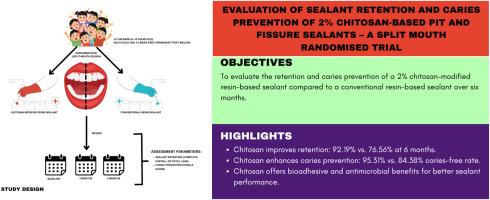2%壳聚糖基牙窝和牙缝封闭剂在第一恒磨牙上的龋留位和预防效果的评价-一项随机试验
Q1 Medicine
Journal of oral biology and craniofacial research
Pub Date : 2025-09-09
DOI:10.1016/j.jobcr.2025.08.032
引用次数: 0
摘要
背景:龋齿是一个重要的公共卫生问题,特别是在儿童中,由于复杂的牙槽和裂隙形态,儿童的咬合面处于高风险中。凹坑和裂缝密封剂是一种行之有效的预防措施,与玻璃离子水泥(GIC)密封剂相比,树脂基密封剂具有更好的保固性。壳聚糖是一种天然衍生的生物聚合物,它可以通过提高树脂基密封剂的机械强度、抗菌作用和附着力来增强密封剂,从而提高密封剂的保持性,减少重复使用的需要。本研究评估了2%壳聚糖改性树脂基密封剂与常规密封剂6个月的固位和龋齿预防效果。方法在某儿科牙科进行双盲、裂口随机临床试验(CTRI/2023/06/054321)。共有38名年龄在6-10岁之间的儿童,每个儿童都有4颗完全萌出的无龋齿的第一恒磨牙,被招募,总共有152颗臼齿,其中32名儿童(128颗牙齿)完成了试验。每位参与者在对侧磨牙上均使用常规树脂基密封剂(Clinpro™)和2%壳聚糖改性Clinpro™密封剂。使用顺序编号的不透明密封信封进行随机化,以确定每侧密封剂的分配。使用浮石浆进行专业预防,然后用37%磷酸蚀刻,冲洗,并在使用密封剂之前按照制造商的说明进行干燥。两种密封剂光固化20 s,并评估其正确放置。在基线、3个月和6个月时进行临床评估。主要结果包括使用改良的保留标准(完全、部分或全部丢失)评估的密封剂保留,以及使用国际龋齿检测和评估系统ii (ICDAS-II)评估的龋齿发生率。采用STATA 18软件对数据进行分析,分类变量比较采用卡方检验确定统计学显著性,正态性评价采用Shapiro-Wilk检验。Friedman检验用于组内随时间的比较,随后采用Durbin-Conover事后检验进行两两比较。ICDAS-II评分的组间比较采用Wilcoxon符号秩检验。p <; 0.05为统计学意义。结果3个月后,壳聚糖修饰的牙体完全固位率为95.31%,而常规牙体固位率为81.25%。6个月时,研究组和对照组的保留率分别为92.19%和76.56%,差异仍有统计学意义(p < 0.05)。在预防龋齿方面,3个月时,研究组100%的牙齿保持无龋齿(ICDAS-II评分为0),而对照组为89.06%。6个月时,研究组95.31%的牙齿保持无龋,而对照组的这一比例下降到84.38%。与传统的树脂基密封胶相比,壳聚糖改性密封胶具有显著的防龋效果。结论将2%壳聚糖掺入树脂基密封剂中,在6个月的时间内,可显著提高牙体的固位和龋齿的预防效果。壳聚糖的生物粘附和抗菌特性可能有助于这些改善的结果。鉴于其延长寿命和预防的好处,壳聚糖改性树脂基密封剂可能作为一个更有效的替代儿童牙科护理。建议进行进一步的研究,扩大随访和样本量,以验证这些发现。本文章由计算机程序翻译,如有差异,请以英文原文为准。

Evaluation of sealant retention and caries prevention of 2 % chitosan-based pit and fissure sealants in permanent 1st molars – A randomised trial
Background
Dental caries is a significant public health concern, particularly in children, where occlusal surfaces are at high risk due to complex pit and fissure morphology. Pit and fissure sealants are a well-established preventive measure, with resin-based sealants offering superior retention compared to glass ionomer cement (GIC) sealants. Chitosan, a naturally derived biopolymer, may enhance resin-based sealants by improving their mechanical strength, antibacterial action, and adhesion, leading to better retention and reduced need for reapplication. This study evaluated the 6-month retention and caries-preventive effectiveness of a 2 % chitosan-modified resin-based sealant versus a conventional sealant.
Methodology
A double-blind, split-mouth randomised clinical trial (CTRI/2023/06/054321) was conducted in a pediatric dental setting. A total of 38 children aged 6–10 years, each with four fully erupted, caries-free permanent first molars, were enrolled, resulting in a total of 152 Molars out of which 32 children (128 teeth) completed the trial. Each participant received both a conventional resin-based sealant (Clinpro™) and a 2 % chitosan-modified Clinpro™ sealant on contralateral molars. Randomisation was performed using a SNOSE (Sequentially Numbered Opaque Sealed Envelope) to determine the allocation of sealants on each side. Teeth were prepared by professional prophylaxis using pumice slurry, followed by etching with 37 % phosphoric acid, rinsing, and drying per manufacturer's instructions before sealant application. Both sealants were light-cured for 20 s and evaluated for proper placement. Clinical assessments were conducted at baseline, 3 months, and 6 months. Primary outcomes included sealant retention, evaluated using modified retention criteria (complete, partial, or total loss), and caries incidence, assessed using the International Caries Detection and Assessment System-II (ICDAS-II). Data were analyzed using STATA 18 software, and statistical significance was determined using Chi-square test to compare categorical variables, Shapiro-Wilk test was used to assess normality. Friedman test was conducted for within-group comparisons over time, followed by the Durbin-Conover post-hoc test for pairwise comparisons. Between-group comparisons of ICDAS-II scores were conducted using the Wilcoxon signed rank test. Statistical significance was set at p < 0.05.
Results
At 3 months, complete retention was observed in 95.31 % of molars treated with the chitosan-modified sealant, compared to 81.25 % in the conventional sealant group. By 6 months, retention rates declined slightly to 92.19 % in the study group and 76.56 % in the control group, with the differences remaining statistically significant (p < 0.05). Regarding caries prevention, at 3 months, 100 % of teeth in the study group remained caries-free (ICDAS-II score 0), compared to 89.06 % in the control group. By 6 months, 95.31 % of teeth in the study group remained caries-free, whereas the percentage dropped to 84.38 % in the control group. The chitosan-modified sealant demonstrated significantly superior caries prevention compared to the conventional resin-based sealant.
Conclusions
The incorporation of 2 % chitosan into resin-based sealants significantly enhanced both retention and caries prevention over a six-month period. The bioadhesive and antimicrobial properties of chitosan likely contributed to these improved outcomes. Given its enhanced longevity and preventive benefits, chitosan-modified resin-based sealants may serve as a more effective alternative for pediatric dental care. Further studies with extended follow-ups and larger sample sizes are recommended to validate these findings.
求助全文
通过发布文献求助,成功后即可免费获取论文全文。
去求助
来源期刊

Journal of oral biology and craniofacial research
Medicine-Otorhinolaryngology
CiteScore
4.90
自引率
0.00%
发文量
133
审稿时长
167 days
期刊介绍:
Journal of Oral Biology and Craniofacial Research (JOBCR)is the official journal of the Craniofacial Research Foundation (CRF). The journal aims to provide a common platform for both clinical and translational research and to promote interdisciplinary sciences in craniofacial region. JOBCR publishes content that includes diseases, injuries and defects in the head, neck, face, jaws and the hard and soft tissues of the mouth and jaws and face region; diagnosis and medical management of diseases specific to the orofacial tissues and of oral manifestations of systemic diseases; studies on identifying populations at risk of oral disease or in need of specific care, and comparing regional, environmental, social, and access similarities and differences in dental care between populations; diseases of the mouth and related structures like salivary glands, temporomandibular joints, facial muscles and perioral skin; biomedical engineering, tissue engineering and stem cells. The journal publishes reviews, commentaries, peer-reviewed original research articles, short communication, and case reports.
 求助内容:
求助内容: 应助结果提醒方式:
应助结果提醒方式:


